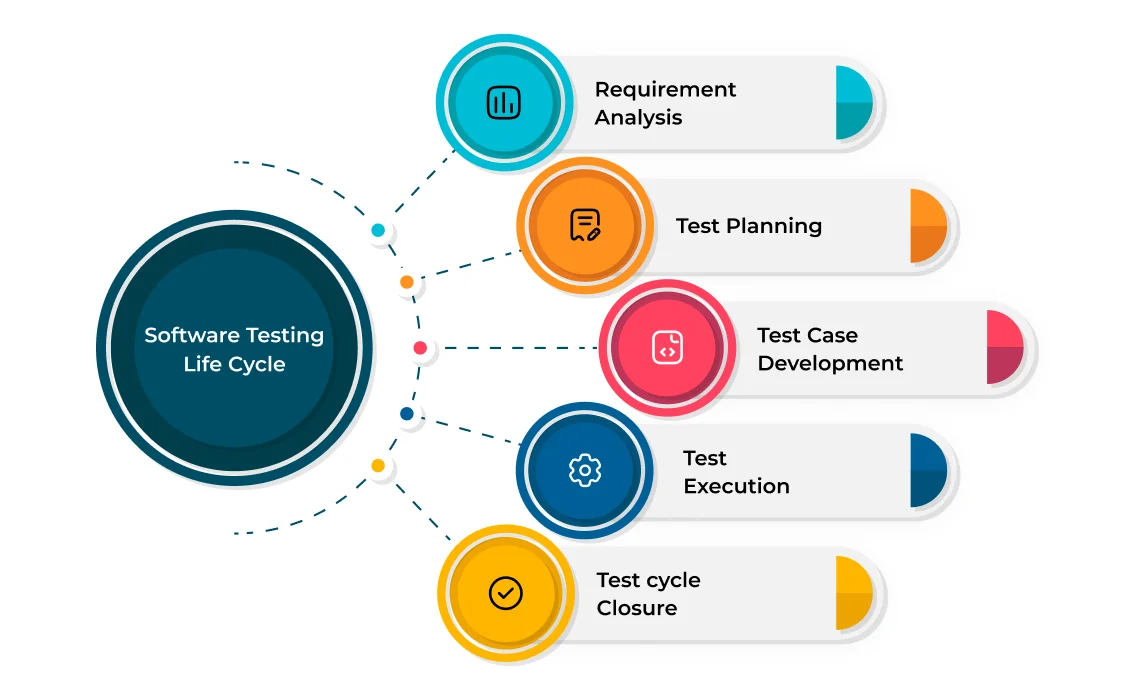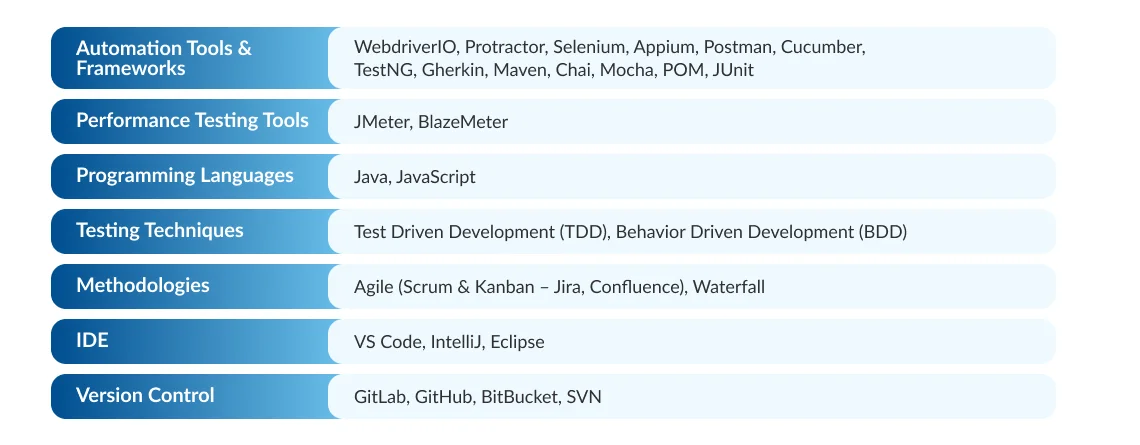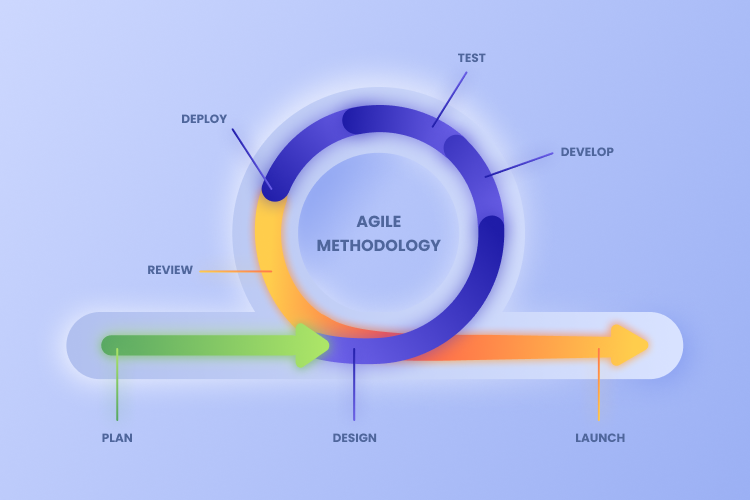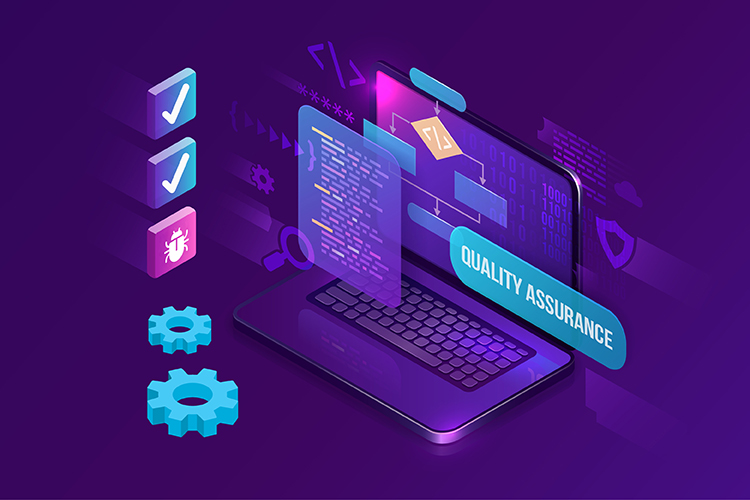Full-Cycle Software Quality Engineering: What’s Included In This QA Service?
- QA
- October 6, 2023
Imagine constructing a towering skyscraper without a solid architectural plan or quality assurance measures in place. It will eventually crumble down during times of high stress or unforeseen disasters.
Just as a building’s structural integrity is paramount to its long-term success, the software you’re developing should possess a similar level of resilience in the digital realm. With full-cycle software quality engineering, you ensure that every aspect—from data processing and accessibility to security and user experience—is built for optimal performance and long-term reliability.
However, no one wants to gamble with their software’s stability and reliability. That’s where full-cycle software quality engineering services come to the rescue.
Research has shown that software quality assurance services can help identify up to 80% of code defects and uncover the 20% of hidden vulnerabilities that could wreak havoc in the future.
So, curious to know if this service can do these wonders? I guess you are!
Let’s get started to unlock the secrets behind adopting a complete software testing life cycle!
What is Software Testing Life Cycle (STLC)?
As the name suggests, full-cycle software testing and quality assurance or software quality engineering is a comprehensive and systematic approach to ensuring the quality and reliability of software throughout its development life cycle. Full cycle software quality testing follows a step-by-step process comprising requirement analysis, test plan creation, test case creation, test execution, bug finding and solving, and rerunning test cases to ensure robust software quality standards.

In short, full-cycle software QA testing service aims to minimize the possibilities of defects, improve user satisfaction, and overall enhance the reliability of your software. It’s an integral part of the software development process, which ensures meeting functional and non-functional requirements by complying with industry-specific standards and Quality Assurance (QA) best practices.
What are the Benefits of Software Quality Assurance?
The adoption of full-cycle software testing and quality assurance (QA) service can offer a range of benefits, contributing to software development excellence, which includes:
1. Ongoing Build Quality Improvement with Early Issue Detection
Ongoing quality assurance with the development is the best practice you can follow. By doing this, your software QA expert can be in harmony with your developers. Together, QA experts and software developers can work, identify errors/bugs during the early development time, and fix them at that moment before they can spread widely and harm other code properties.
This full-cycle software quality testing and assurance, not only fixes bugs during development time but also reduces costs and efforts that can emerge post-development.
2. Enhanced User Experience
In the comprehensive QA service, you also get coverage for the software reliability and usability testing services, which ensures that the software development code quality is top-notch and high in performance that users love to use. This enhanced user experience in software quality testing leads to increased user satisfaction, better market reputation, and higher software adoption rates.
3. Minimized Business Risks
Better software quality development means a better market reputation for your software-oriented business. As Quality Assurance helps to reduce risks associated with software failures, data breaches, and compliance violations, it significantly leads to increasing positive market reputation, thus minimizing business risks and taking it towards excellence.
4. Launch Your Product Confidently
As full-cycle software testing and quality assurance services comprise all required tests to find even granular bugs, you get the final product, which is bug-free, crash-free, and overall – highly performant.
So, what else does your business-critical software need? You will get a robust digital product on your hands that users prefer to use; hence, you can confidently launch it in the market and expect better results.
5. Adherence to Industry-specific Standards
Every industry has its own set of standards and regulations, which every business (when entering) must comply with to avoid further consequences. Opting for the comprehensive quality assurance and testing service from a top-notch software QA partner can help to ensure those digital industry-specific security standards and best practices.
After all, these standards are for your own benefit, helping you make your product robust enough to deal with cyber clashes and user peak cases. Industries like healthcare, finance, etc., follow rigid standards and regulations for digital products, considering the importance of customer data.
6. Competitive Advantages
Organizations that opt for full-cycle software testing and quality assurance services for their digital products often gain a competitive advantage as it helps them to deliver superior quality products that meet and even exceed users’ expectations.
Oh, okay, so this is why we should go for the full-cycle software testing and quality assurance services. But what are the situations in which going for this service is a must? Well, the next section is all about that!
When to Opt for Full-cycle Software Quality Assurance Service?
Opting for a full-cycle software quality assurance (QA) service is a strategic decision, which is taken by considering various factors. So, you should go for this service:
At the starting time of product development
This should not be a choice but a necessity. Because with great ideas come great efforts to achieve better outcomes. Adopting the software QA service from the planning stage of the product is a great choice as it helps to build the development plan, enforce quality standards, and identify potential issues quite considerably to avoid future difficulties.
Complex and Critical Projects
Though QA service should be the priority from the early stage for all types of projects, it is a must-need for projects that are complex in nature. Now, what such complex projects could be? We can consider projects from industries like healthcare and finance as the most important ones, where software reliability and security are paramount.
Projects with Regulatory Compliance Requirements
We all know that the healthcare and finance industries are quite user-information-sensitive ones. And software from these ones must meet their industry standards (e.g., HIPAA for healthcare products and GDPR, PCI-DSS, and more for fintech apps) for better reliability. This situation makes it a compulsion to opt for full-cycle software quality engineering and testing services.
Adoption of New Concepts and Technologies
When working on new software concepts and adopting new technologies for its software development, it’s necessary to implement full-cycle software quality measures to conduct thorough testing and uncover potential software issues and compatibility challenges.
Resource and Expertise Gap
You are developing your software product with the help of your in-house developer staff but don’t have particular expertise for the QA tasks. In such cases, hiring dedicated QA engineers or outsourcing your QA tasks to a reputed company to take care of it can be a valuable solution.
Software Upgrades and Migration
You do need the support of QA services even after the product is completely developed and launched. Because technologies are always upgrading, and many new ones are entering the market, there is a constant need to upgrade your product accordingly.
For that, you also need to upgrade your code, which can raise new issues. To fix them, you need to opt for regression testing and other associated QA measures, all of which fall under full-cycle software quality engineering to ensure continuous reliability and performance.
Not just in this case, but also when migrating your software from one platform to another, you need to reassess its quality to maintain its build integrity.
Noted! We now understand when and in what cases QA services are essential. As full-cycle software quality engineering covers much more, knowing the skill sets to look for when choosing a software testing partner can be of great help! You asked, we heard! Let’s move on to the next section to figure out the required software quality engineering skills for your project.
What are the Software Testing and Quality Assurance Skills you Require?
There are many factors to consider when hiring QA engineers from a software development company for your mission-critical software project. Also, software quality assurance engineers have diverse skill sets, among which, here are a few QA skill sets they must have and you must consider:
- Familiarity with various function, non-functional, user acceptance testing (UAT), security testing, and automated testing methodologies;
- Ability to create effective test plans with testing objectives;
- Proficiency in designing detailed test cases and scenarios, meeting software reliability standards;
- Proven skills in defect management using tracking tools to identify, report, and manage defects under different categories and priorities for better resolution;
- Better understanding of the latest software programming and scripting languages for creating automated test scripts;
- Expertise in using test automation tools and frameworks, like Selenium, Appium, JUnit, Postman, Protractor, Mocha, and many others;
- Experience in performance testing using tools like JMeter and BlazeMeter;
- Familiarity with API testing tools like Postman and RestAssured.
- Hands-on practice in using testing techniques, like Test-Driven Development (TDD) and behavioral Driven Development (BDD), and methodologies like Agile (Scrum & Kanban – using Jira and Confluence) and Waterfall models;
- Integrate automated tests into the CI/CD pipeline to enable early and frequent testing;
- Know how to utilize version control tools like GitLab, GitHub, Bitbucket, and SVN;
- Collaborate with cross-functional teams to ensure that quality standards are met throughout the software development life cycle.
It’s quite an extensive list of the required skill sets for QA engineers, isn’t it? Now, you must be curious about the execution of software testing and quality assurance processes. So, let’s not wait much and get on to it!
What’s Covered in Full-cycle Software Quality Engineering Service?
As the name suggests, full-cycle software testing and quality assurance service encompasses a range of sub-services, which are performed in the following manner:
Requirement Analysis
Requirement analysis is an important phase in the software development and testing life cycle. It helps you understand software type, requirements, use cases, userbase, and a lot more to create its quality assurance strategy with planned test cases and scenarios. QA engineers associated with your software project from the initial phase helps you:
- Analyze software requirements from the prepared specification report and its listed use cases;
- State high-level configuration scenarios to meet;
- Verify and check out for the software functionality requirements;
- Provide suggestions related to logic types and features to implement;
- Raise and track defect detection or clarification required in the software specification document.
Testing Planning
Before we get started with the QA test planning, let’s first understand “What is a QA test plan?”
QA Test planning is a documentation approach that focuses on creating a detailed test plan that outlines the type of software tests to be performed, necessary steps/activities for the tests, scope, objectives, required tools and resources, timeline, potential risks, staffing needs, and other critical assumptions and dependencies.
You must be curious to know, “Why do you need a QA test plan?” It’s simply to identify potential software development and test issues early on and go with the planned approaches to avoid end-time procrastination.
And how to create a good test plan? For this task, the previously created requirement analysis document helps a lot.
- Analyze the software plan
- Consider the target audience
- Create a QA strategy
- Define objectives based on SMART Technique (Specific, Measurable, Achievable, Relevant, and Time-bound)
- Determine suspension and exit criteria of the test
- Plan resources, like who will work on this project, required time, tools, and QA testing budget
- Plan the test environment by identifying the location to perform tests, defining devices and resources for conducting these tests
- Creating a format to report test results
In short, a test plan is a highly effort-intensive strategic stage that involves extensive analysis, research, and scenario simulation to create the best plan, providing heads-up and valuable guidance during execution.
Test Cases Designing
We have done a management task by creating a test plan. But to take it into more depth to the technical level, the test case designing process helps a lot. Test design is a process that defines procedures and required steps to execute a test. It focuses on the required test techniques, test data, scenarios, cases, resources, and planning expected test results.
Designing a test is an assumption-based task; here, QA engineers have to be specific regarding the mentioned test cases. The purpose of test designing is to get better ROI by focusing on the test effectiveness and testing strategy.
Hence, test design is rewarding for both manual and automated test cases.
Test Execution & Ongoing Test Observability
Finally, after the planning and strategy-clearing phase, it’s time to run the test cases to identify defects, errors, or deviations from expected behavior. In the full-cycle software testing and quality assurance service, test execution is an ongoing process while keeping test observability in mind.
But what is test observability?
Observability in testing enables QA engineers to get each and every detail regarding software defects, raise concerns, and find solutions. Test observability is an automated CI/CD pipeline-based DevOps testing approach that helps to take care of software QA metrics like performance, stability, reliability, running time frequency, and get alerts on regression in behavior, and much more.
Continuous software testing during the development phase helps to keep the ongoing build in check and fix it right away with Unit testing and other important measures to ensure precision-based code performance.
Now, let’s see core software test cases for better understanding:
Functional Testing
Functional testing ensures the working of each application feature as planned during the software requirement planning. In this, each function is compared with the plotted requirement to check whether it meets end-user expectations or not.
Functional testing is more concerned with the logic used in the implementation of the feature. It ensures that the user can log into the app using the right credentials or not from the login page. In the case of a payment gateway, it checks whether it rejects the payment request upon entering the wrong card number or PIN. So, just like that, it checks the working accuracy of the implemented feature.
Functional testing comes with many testing types, including:
- Unit Testing: Focused on individual components or functions;
- Integration Testing: Configures how different components of the software or different services work together;
- System Testing: Assesses the entire software ecosystem to check if it meets defined functional requirements;
- User Acceptance Testing: Checks if the software meets the functional requirements of end-users;
- Regression Testing: Ensures that the updated software code does not impact the overall code and introduce new bugs;
- Smoke Testing: Executed quickly to check the working of the basic functionalities of the software;
You can conduct these functional tests manually and automatically. To do so, you require tools and frameworks like Selenium, Appium, Cucumber, JUnit, Postman, TestNG, etc.
Regression Testing
After the complete test and fixing the initial issues, you want to check whether all reprogramed functions work well in the software developed or not. Well, it’s not the linearly-oriented test case, but the one that is often performed after every change done unto the code.
This test, along with the performance of the functions, does help to verify the changes done to the codebase are not impacting the other code parts. Here, the changes could be adding or removing new features, fixing bugs, or updating existing features.
Most of the regression software tests are performed through automated procedures. Remember that regression tests can be performed manually, but this process can be effort-intensive, time-consuming, and may lead to tons of errors or bottlenecks. On the other hand, automated regression tests are proven to be more efficient and accurate.
Regression test has several types, including corrective, progressive, selective, partial, complete, and retest-all.
- Corrective regression test helps to check the working of the existing code;
- Progressive regression test helps to check the modified code base;
- Selective regression test checks the effectiveness of the selected code base;
- Partial regression test helps to check the impact of new elements across the code and functions;
- A complete regression test is a comprehensive one that checks the effect of code changes in the entire code base;
- Retest all is just like the complete one, which re-executes all test cases to find potential bugs and code issues.
You can utilize tools like Selenium and Apache JMeter to conduct regression tests.
Non-functional Testing
It’s the opposite of functional testing, which solely focuses on the non-functional requirements of the software product. It checks the behavior and readiness of the system whether it meets the requirement or not.
The objective of the non-functional testing is to:
- Increase usability, efficiency, and compatibility of the software;
- Reduce production risks and costs;
- Enhances product installation, execution, and monitoring rates;
- Gather and create metrics for software research and development;
- Enhance product behavior and used technologies.
Non-functional testing suite covers:
- Compatibility Testing: Ensures the compatibility of the software across platforms, browsers, devices, or operating systems;
- Performance Testing: As the name suggests, it checks how well the software performs under various test scenarios;
- Security Testing: Run to find out security bugs and loopholes to fix that can compromise your software product;
- Usability Testing: A UI/UX side testing to check its visual appealingness;
- Scalability Testing: Determines the load capacity of the software to deal with the sudden increase in software user traffic;
- Compliance Testing: Ensures that it meets software compliance standards, such as HIPAA for healthcare products, etc.;
- Endurance Testing: Helps to check continuous, long-term reliability of software;
- Load Testing: Checks for the compatibility of the software to deal with loads of user requests;
- Recovery Testing: Tests the recovery rate of the system failure and data.
There are many as well, including volume and stress testing adding up to the load testing. To execute all these non-functional test cases, you require tools and frameworks like Apache JMeter, Blazemeter, and many others.
Test Automation
Test automation is the strongest alternative to manual testing, which utilizes powerful tools to create and execute automated tests to get quick results to improve the software quality. The purpose of test automation is to minimize human efforts and time associated with writing manual test scripts; and, thus, cost. To do the test automation, you need support from business analysts, developers, DevOps engineers, and QA automation engineers.
You can automate tests like code analysis, unit, integration, acceptance, performance, smoke, and other functional and regression test cases.
In test automation, the CI/CD pipeline of the DevOps practice also plays an essential role by helping to automate the test cases along with the software development and delivery. It conducts tests and checks the build quality of the code before shifting it for the delivery of code to the final build.
Not just that, the QA automation engineer also establishes quality gates or checkpoints in the CI/CD pipeline to ensure whether the code is eligible for the next deployment stage or not. It also helps to reduce the time invested in the testing time and helps to deliver the product with faster time-to-market.
To automate your tests, you can use tools and frameworks like Webdriver.io, Protractor, Selenium, Appium, Postman, Cucumber, TestNG, Gherkin, Maven, Chai, Mocha, POM, and JUnit.
QA Documentation
QA documentation is made of many documents created by QA engineers during software development and test processes. This documentation may cover testing strategy, test cases, test scripts, test logs, bug reports, and potential details related to their fixes. Moreover, QA engineers work on this documentation from the beginning till the time the software is deployed to its respective platform.
This helps to keep the entire QA team on the same page and provides a quick overview of what’s going on for the testing project. This is not only beneficial for the QA team but also for the clients curious to know updates regarding their pivotal software testing project.
Apart from this, below are the reasons stating the importance of the QA documentation:
- QA documentation covers every information that testing engineers need to follow;
- Helps to have an eye on listed defects and solve them as early as possible;
- As it documents testing procedures, controls, and much more, it offers preventive measures to mitigate risks and their impact on businesses, helping elevate customer satisfaction;
- With this, you can also quickly onboard any new QA talent to your software testing project to play their part;
- Because of the documented information like non-conformances, corrective actions, and lessons learned, the business can refer to it to find out areas of improvement and work on changes accordingly;
- A well-documented QA process plays quite a big role in enhancing software customers’ experience and their confidence in your business;
- Even at the time of legal disputes or product recalls, your well-crafted QA documentation becomes vital evidence, suggesting that the team has taken care of quality processes, required precautions, and a lot more.
Well, to create this QA documentation, you need to hire QA engineers from big firms with designated QA teams, project managers, business analysts, and a huge development team, to work on your project as they have a proper format to do the same.
Quality Assurance and Product Improvement
In this process, QA engineers may conduct their final software quality assurance examination. With this, they get confidence in the product build quality before clearing it for release.
This inclusion in the full-cycle software testing and quality assurance service ensures that your team is trustworthy and known for their best practice to ensure the high standard of build quality that helps you take your software solution to excellence.
Also Read: 3 Quick Ways to Measure the Code Quality of Your Mobile App
Release Management
After the software testing and quality assurance measurements, it’s time to release your software to its respective platform. During this, your hired QA engineer will be in constant touch with your development team to ensure its smooth release.
Post this, the test closure process will come, in that your QA team will complete all formalities of verifying documents and making necessary changes to ensure a smooth handover of necessary documents.
What Software QA Testing Tools, Frameworks, and Methodologies to Consider?
In the market, you’ll find loads of tools, frameworks, and methodologies to use for your software testing project, but you should consider the following ones for better QA testing results:

Along with the best-in-class software testing and QA tools, frameworks, and methodologies, you should also know about best practices to use them. Worry not! The next section is all about that!
What are Software Testing Best Practices?
Software testing and quality assurance best practices help to ensure the efficiency, effectiveness, and thoroughness of the entire process of building high-level software products. So, here are a few software testing and quality assurance best practices to ensure the top-notch build quality of your mission-critical software product:
- Employing software testing and quality assurance measures from the beginning of the software development life cycle;
- Take part in the software requirement analysis processes to understand the need for its build quality and performance;
- Develop a detailed test plan covering information about resources, test cases, practices, test schedules, and much more while taking care of the core objective of the software concept;
- Create test documents in such a way that offers transparency and traceability of the test cases and their results to refer to in future scenarios;
- Create well-structured test cases with utmost analysis and thinking that cover all sides and impacts of test cases, boundary tests, and edge cases;
- Keep the QA documentation up-to-date with the latest bugs/defects, test results, and findings for better reference and defect and software quality management;
- Take the help of test automation to cut down the extra time taken and cost involved for the testing scenarios and utilize the remaining time in other software development competencies;
- Ensure to conduct regression tests, either manually or automatically, after every new amendment to the code to ensure the intactness of the code properties and their effectiveness;
- Foster a culture of effective communication and collaboration to ensure transparency across teams and derive the best-in-class outcomes.
How Much Does a Full-cycle Software Testing and Quality Assurance Service Cost?
Well, assuming a cost to test and quality assurance to build the quality of your software product is quite tough without knowing the objective of your software. Also, the cost of a full-cycle software testing and quality assurance service can vary depending on factors such as:
- The length and complexity of the software;
- Specific software testing requirements;
- The location of the software testing service provider;
- The level of expertise and experience required for the QA engineer;
- No. of talents needed to hire;
- The dedication required from the talent;
- The engagement model selected;
- Regulatory compliance requirements;
- Further maintenance and support requirements, and much more.
However, the location of the talent plays an influential role in calculating the cost of the full-cycle software testing and quality assurance service.

How Can MindInventory Help You with Software Quality Engineering?
Software testing and quality assurance is a crucial part of the software development life cycle, on which your entire brand reputation depends. Some industry experts also consider this service as a gateway to digital business excellence. With effective software quality engineering service, you can get the confidence to launch your software product without any worries.
But to do it all effectively, you will need the support of a highly qualified team of software QA engineers! That’s where MindInventory, as your trusted software testing and quality assurance company, comes to your rescue! MindInventory has been helping clients develop robust software products and launch them confidently by providing high-end quality testing and engineering services.
So, planning to build high-end software for your mission? Share your software requirements today and get the best solution with a quote soon!
FAQs on Software Quality Engineering
Documentation in the full-cycle software testing process is crucial in keeping track of every test case and its results to ensure transparency across QA team members and for better future reference.
Conducting software testing in agile and DevOps environments can raise unique challenges. Hence, to tackle those, QA engineers also have to adopt various effective strategies, like shift-left and right testing, test automation, CI/CD pipeline implementation, cross-functional teams, exploratory testing, defect management, test data management, adopting continuous development and test case monitoring and feedback loop, risk-based testing, and utilizing the latest software development and testing tools and frameworks.
It’s very simple to identify the difference between manual and automated testing but may contain various factors to cross-check. While manual testing asks for the involvement of human interactions with the software, automated testing asks for human efforts to write test automation scripts. Considering the importance, manual testing is valuable for exploratory and usability testing, while automated testing is recommended for regression testing and ensuring functionality consistency.













